Global Healthcare Private Equity Report

At a Glance
- Despite a drop in deal volume in 2023, healthcare IT attracts investment due to its ability to drive innovation and offset macro factors such as inflation, labor shortages, and reimbursement headwinds.
- Providers use IT to focus on revenue cycle management, clinical workflow optimization, and patient engagement; biopharma on clinical trial digitalization, analytics, and real-world evidence; and payers on member engagement and value-based care.
- Increasingly, organizations must balance software integration, vendor management optimization, tech stack simplification, and interoperability with best-of-breed solutions.
- Artificial intelligence and the move toward platforms are transforming the healthcare IT landscape.
This article is part of Bain's 2024 Global Healthcare Private Equity Report.
Healthcare information technology (HCIT) sits at the intersection between the steady resilience of the healthcare sector to recession and the high returns of the software and broader IT sector. The result: an attractive upside potential with lower downside risk (see Figure 1).
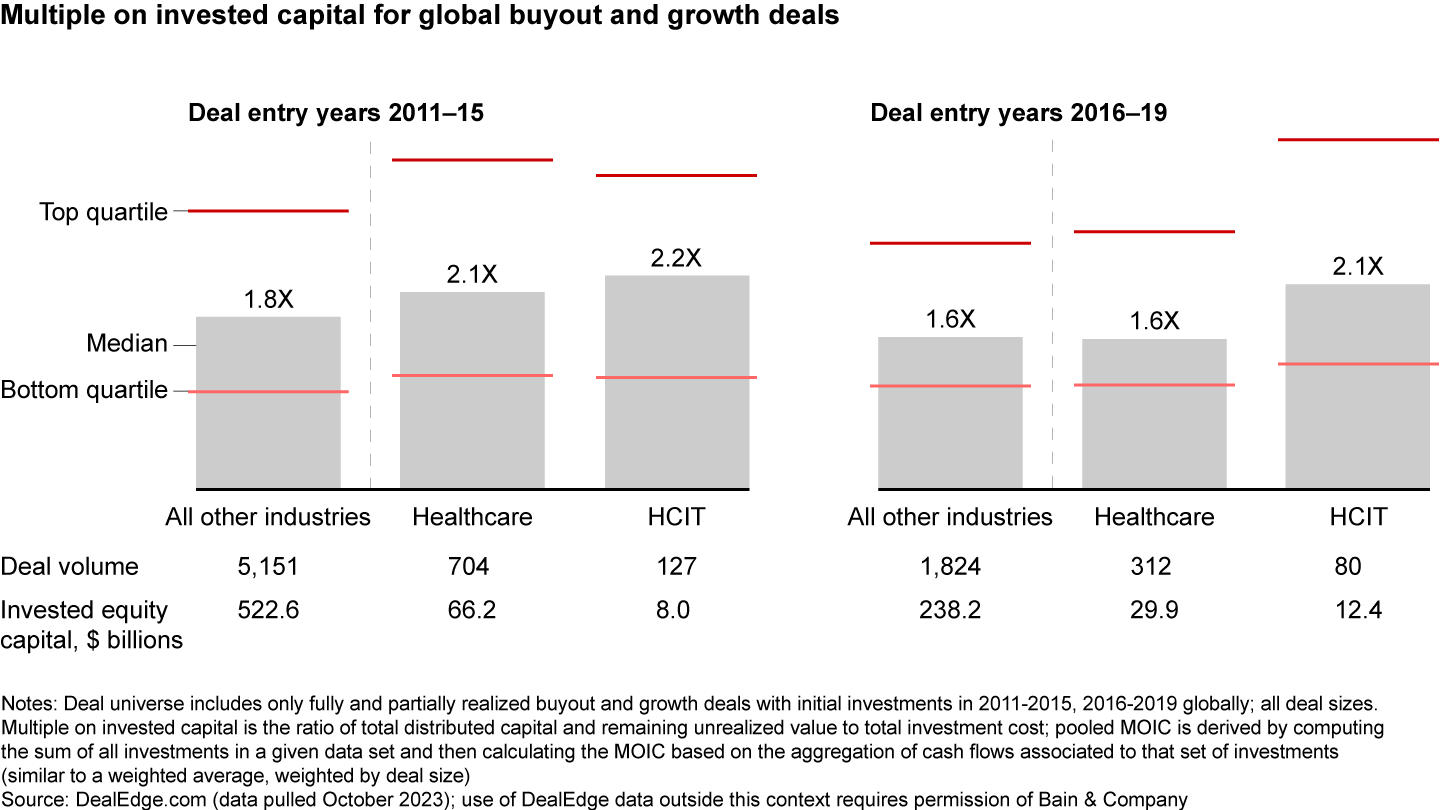
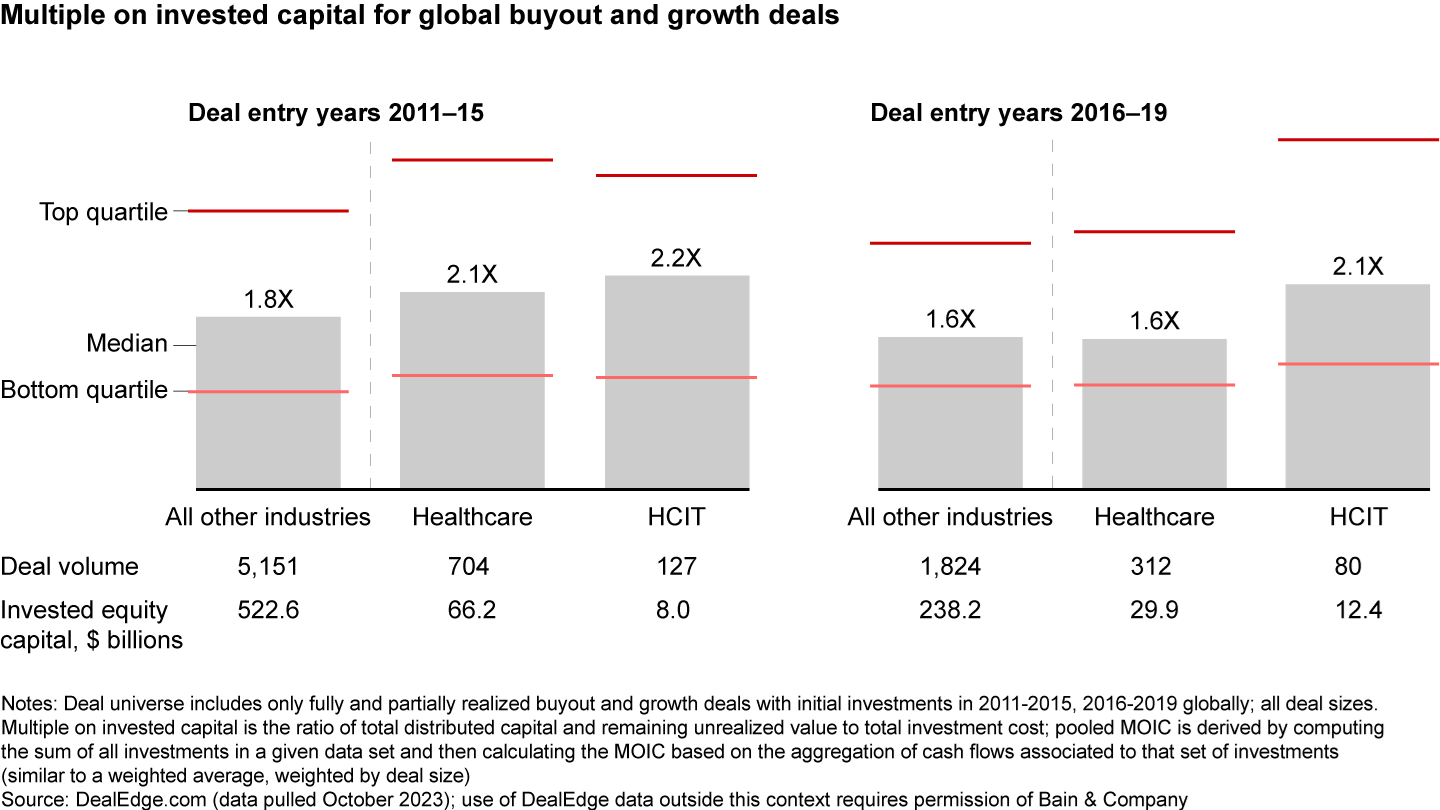

Interested to see which HCIT subsector generated the highest MOIC?
The results may surprise you. Unlock deeper insights with DealEdge.
In 2023, HCIT buyout activity slowed, with deal volume falling by a projected 23% from 2022 , driven mainly by a falloff in provider HCIT transactions (see Figure 2). Excitement around digitalization, following the outbreak of Covid-19, resulted in a slew of portfolio companies that are still early in their holding periods. Despite the decline in transactions, HCIT represents 10% of healthcare sector deal volume and has seen some sizable deals, including EngageSmart, Nextech, NextGen, and CorEvitas.
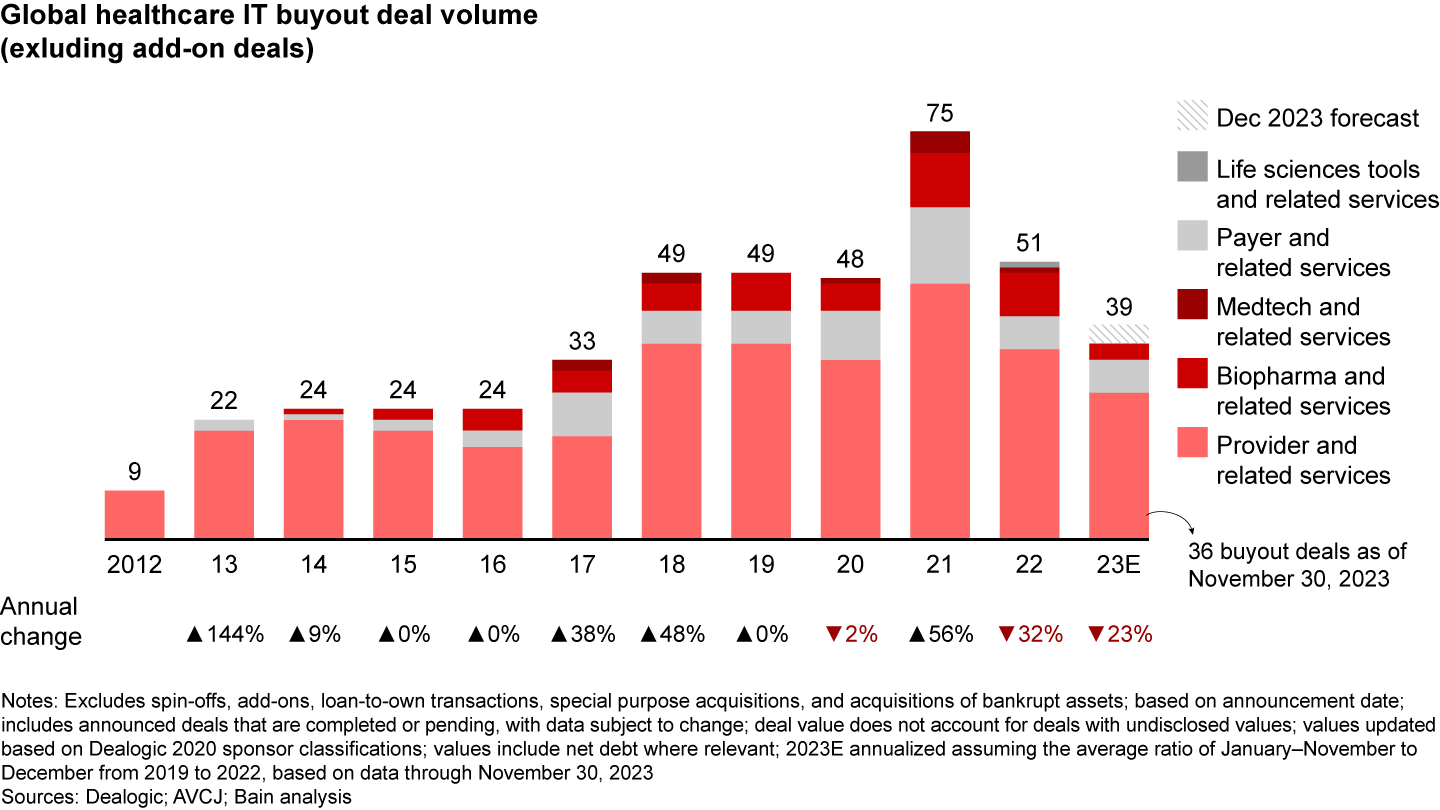
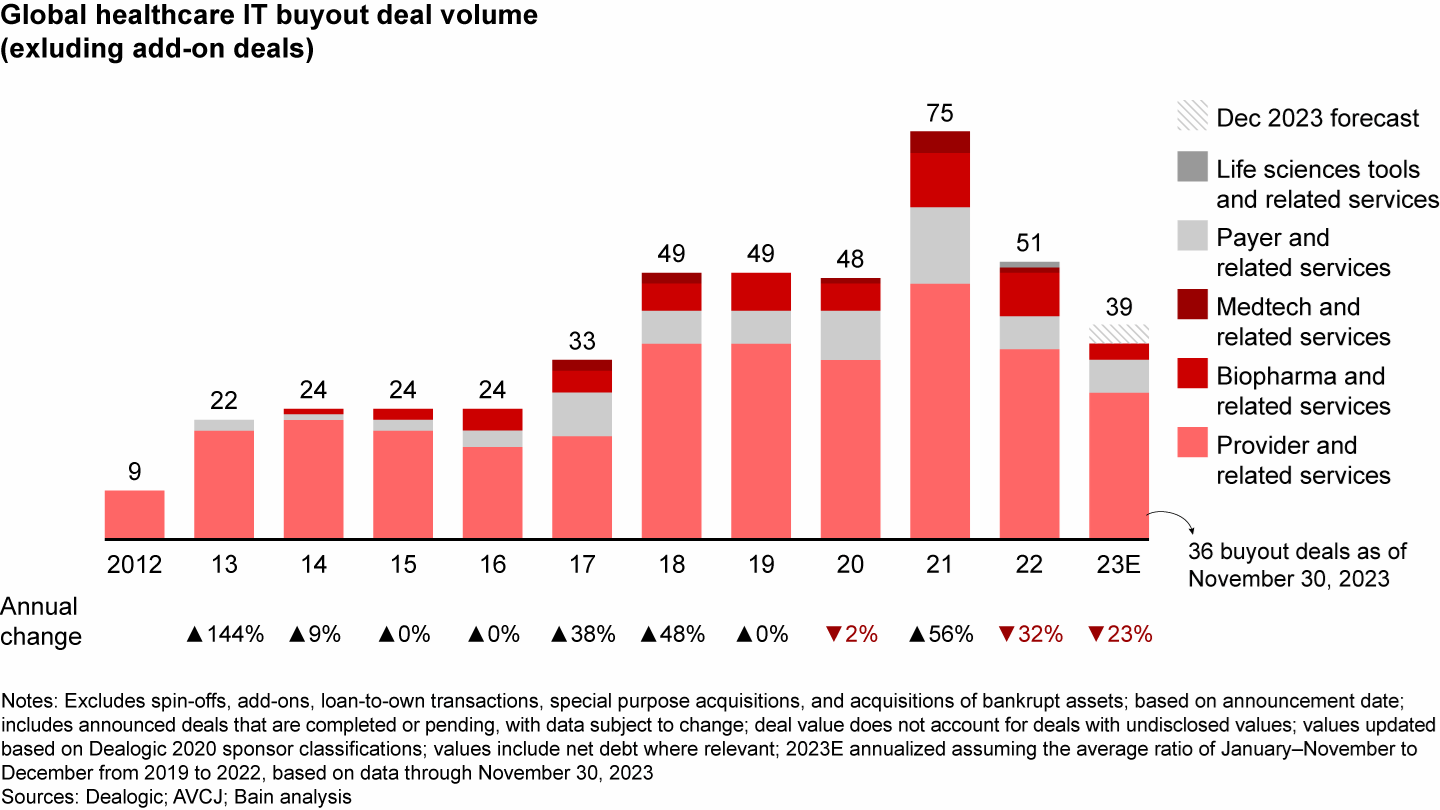
Macroeconomic factors including inflation, labor shortages, and reimbursement headwinds continue to push healthcare operators toward greater automation to raise labor productivity, resulting in investments around workforce management, revenue cycle management (RCM) solutions, drug development workflows, and payer-workflow support. This impetus comes at a time of emerging generative artificial intelligence (AI) models that could unlock process efficiencies and outcome improvements for the industry.
Providers still seeking HCIT to improve their business
Recent Bain-KLAS analysis highlights that IT has become critical to providers as they navigate challenges, accelerating investment in some pockets of the market. RCM, clinical workflow optimization, and patient engagement are top priorities for new investments given that they all deliver measurable return on investment (ROI) (see Figure 3).
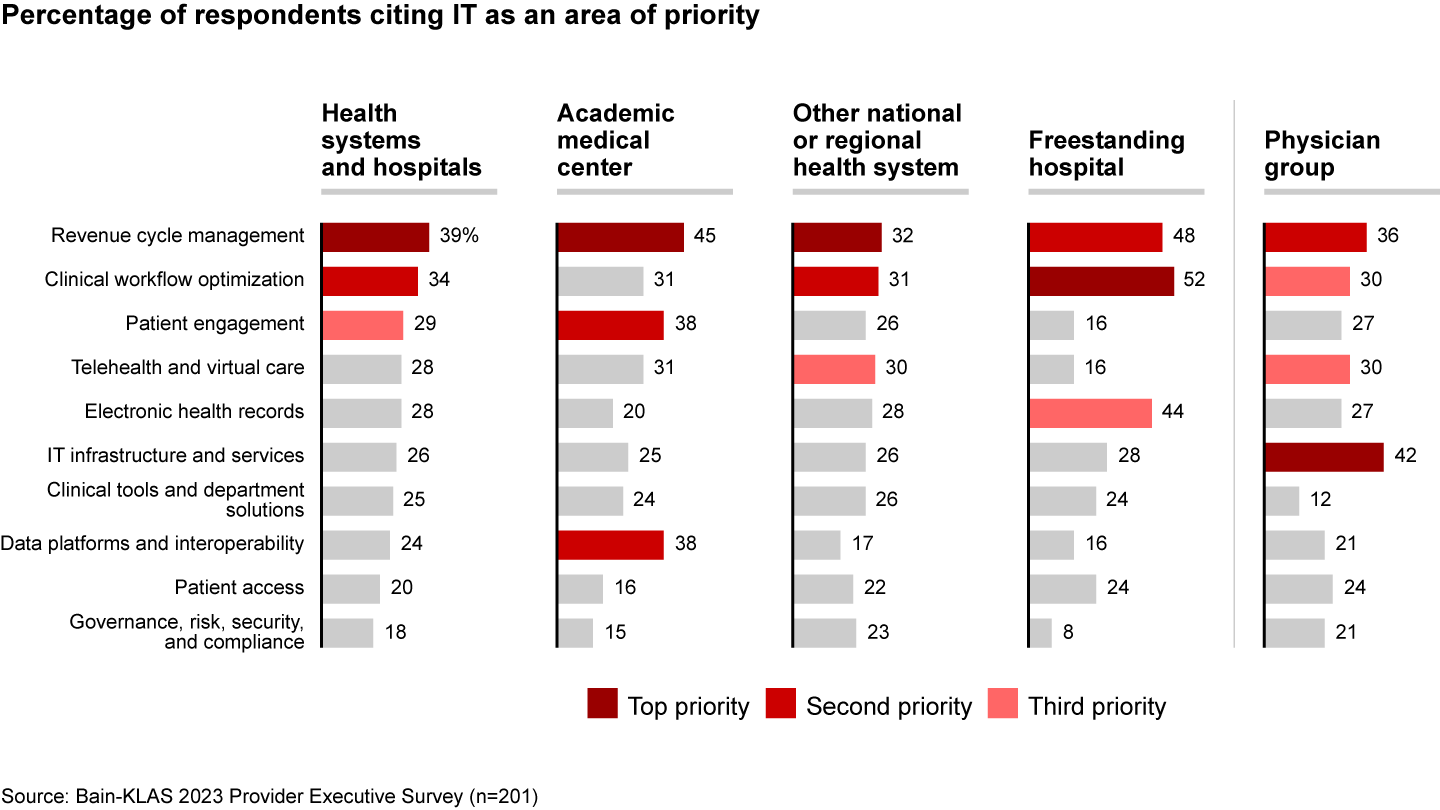
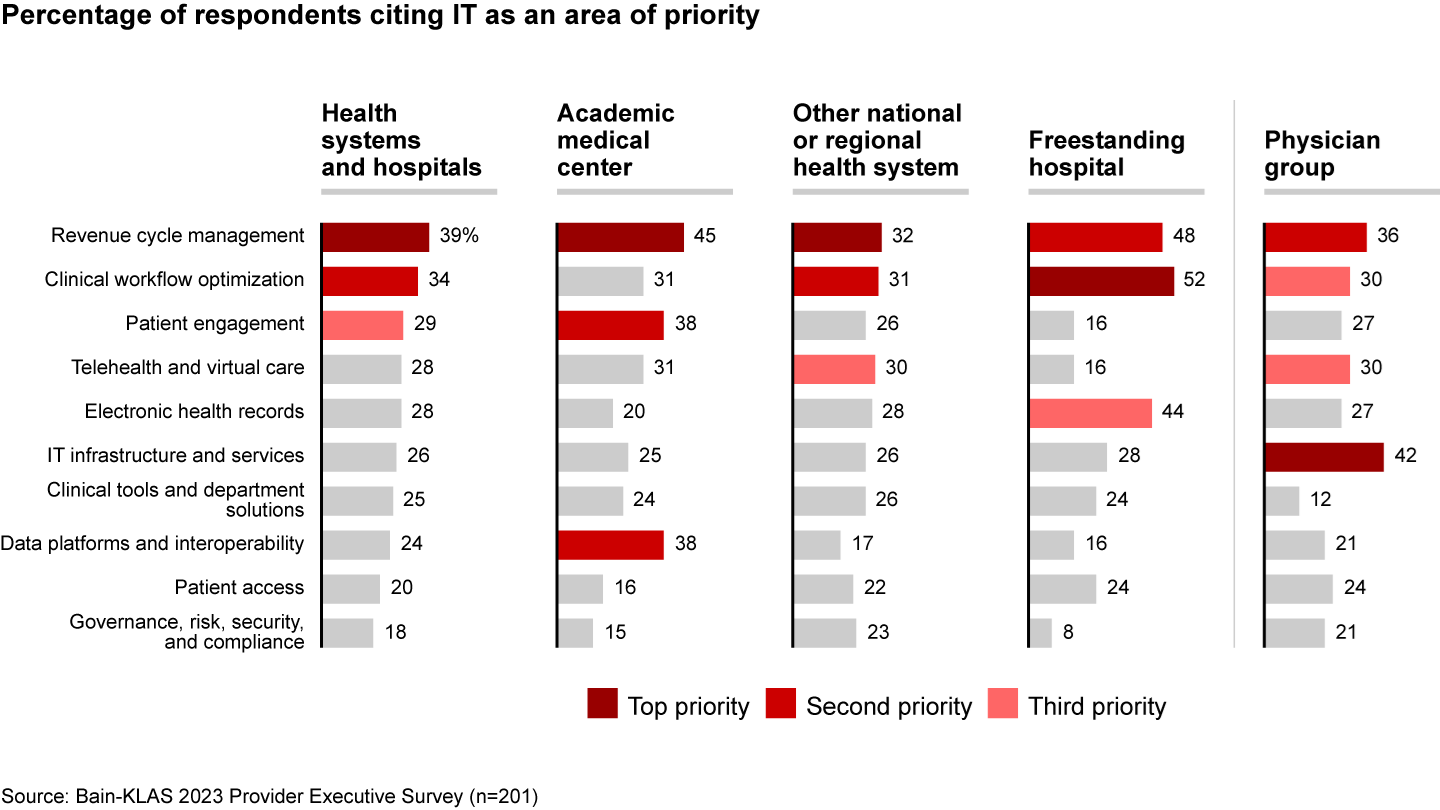
Revenue cycle management. RCM creates value by enhancing collections and streamlining labor-intensive processes, thus generating an ROI for providers. No wonder that providers cite RCM as a top priority, anticipating higher spending for software across a broad set of subsegments including revenue integrity, charge capture, and complex claims management. Select activity in 2023—including TA Associates’ investment in Alpha II and Alpine’s acquisition of Medusind—demonstrated private equity (PE) investors’ interest in this space.
Clinical workflow optimization. Providers are leaning on tools that improve workflow efficiency, such as LeanTaaS’s expanded offerings with the AI tool iQueue Autopilot, or that enhance remote patient monitoring—as in the case of the merger between LAMF, a special purpose acquisition company, with Nuvo, a digital pregnancy care solution. Solutions that save clinicians time while improving patient outcomes present valuable opportunities.
Patient engagement. Academic medical centers and health systems are focusing on enhancing patient engagement as well as using data platforms to further address value-based care and data monetization. Importantly, the benefits of improved patient engagement extend beyond provider-patient relationships into clinical trial applications, improving retention and compliance and ultimately ensuring respect of trial timeline and better outcomes.
Biopharma and payers taking the next steps on HCIT
The role of HCIT in achieving efficiencies for providers is well known, but HCIT offers multiple benefits to biopharma and payers, too.
Biopharma HCIT continues to focus on the role of clinical trial enablement and digitalization in the wake of regulatory changes. Given rising R&D costs, biopharma companies look for solutions that cut costs. As a result, some large e-clinical platforms could be interesting near-term targets.
In addition to e-clinical platforms, biopharma HCIT has opportunity to capitalize on real-world evidence (RWE) and real-world data (RWD) trends. RWE and RWD have grown more popular in recent years, as pharmaceutical companies become more sophisticated in analyzing data across clinical and commercial use cases. Thermo Fisher’s acquisition of CorEvitas and the announcement of CMS to require patient registry enrollment to access Alzheimer’s drugs under Medicare coverage are examples of how critical real-world evidence and data will continue to be in the future.
Payers, meanwhile, have aimed their investments at technology that affects member engagement, ranging from performance and quality to value-based care, including enablement such as care coordination and patient engagement/navigation. The merger of HealthComp, a benefits and analytics platform, with Virgin Pulse, a health and wellness company, exemplifies how payers are integrating with patient platforms to drive care outcomes. Other pressing issues include risk adjustment to payment integrity. Payers continue to look for ways to optimize these payment-related functions, which directly affect their bottom line.
Three themes to guide new investments
Investors should keep three themes in mind when evaluating HCIT opportunities.
- Role of large tech companies and generative AI. Large, generalist technology companies such as Amazon, Microsoft, and Google are expanding into HCIT, either through core services such as Amazon Web Services and Microsoft’s Azure cloud computing platforms, or via AI capabilities such as Microsoft partnering with health systems to use Azure OpenAI. Historically, large tech companies lagged HCIT-focused firms due to lack of customization around healthcare workflows, but some of their recent investments are targeting healthcare. Consequently, more than half of the providers responding in a recent Bain-KLAS survey said they expect to accelerate IT spending with large tech firms, a 12-percentage point increase from the prior year. The exposure level presented by large tech players varies by HCIT subsegment.
HCIT businesses use generative AI as a tool to develop new products or improve existing ones, although many of the applications remain in a nascent stage. That said, certain trends have emerged. Among providers, for example, generative AI is helping to increase efficiency and improve workflows, particularly when built into RCM solutions. And while just 6% of health systems have a generative AI strategy today, about 50% are developing one or are planning to. In biopharmaceuticals, generative AI is supporting and accelerating drug-development workflows and enhancing commercialization capabilities (see “Generative AI Will Transform Healthcare”).
- Platforms’ role in integrating IT solutions. From provider to biopharma, organizations are looking to maximize software integration, optimize vendor management, simplify their tech stack, and enhance interoperability (see Figure 4). Tighter integration remains a key purchasing criterion for companies evaluating IT solutions. Consequently, Epic is taking a greater share of the hospital and health system space (more than 60% of US hospital market share by net patient revenue), given its expanding network effects. Investors should carefully consider Epic’s offerings and development roadmap, as Bain-KLAS research shows that most providers prefer native electronic health record (EHR) offerings.
In the biopharma e-clinical space, many companies are trying to reorganize their tech stack and provide a simpler access point for patients and clinicians. As a result, hub offerings such as Veeva and Medidata that connect multiple stakeholders, digitize, and streamline steps in the clinical trial and patient engagement/communication value chains will continue to play a critical role. Biopharma companies are striking a fine balance between platforms and point solutions, optimizing for the need of interconnectivity and decision-makers’ and users’ desire to seek best-of-breed tools.
- Investors’ integrated due diligence and post-acquisition playbook. As the market becomes more competitive and risks evolve, integrated due diligence and post-acquisition playbooks become critical for assessing and underwriting sources of value and winning deals. HCIT due diligences have evolved from pure penetration and attach-rate analysis, toward integrating commercial excellence, pricing, R&D optimization, product functionality assessment, tech-stack fit for purpose, engineering team’s ability to innovate, cybersecurity gaps, and other operational and tech levers. Moreover, as HCIT platforms grow and offer less opportunity for bolt-on acquisitions, the role of M&A becomes more nuanced as there will be fewer transactions capable of meaningfully moving the needle.
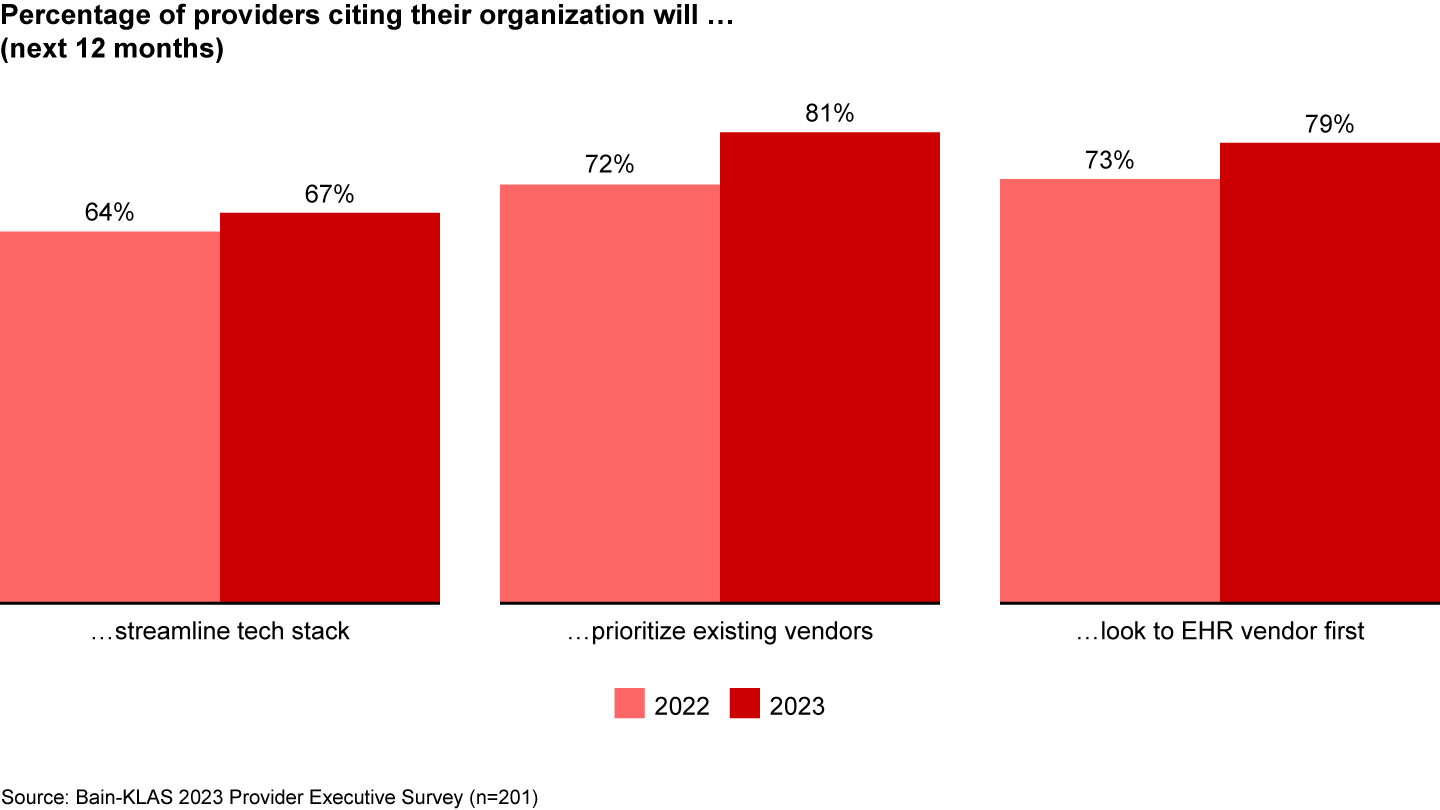
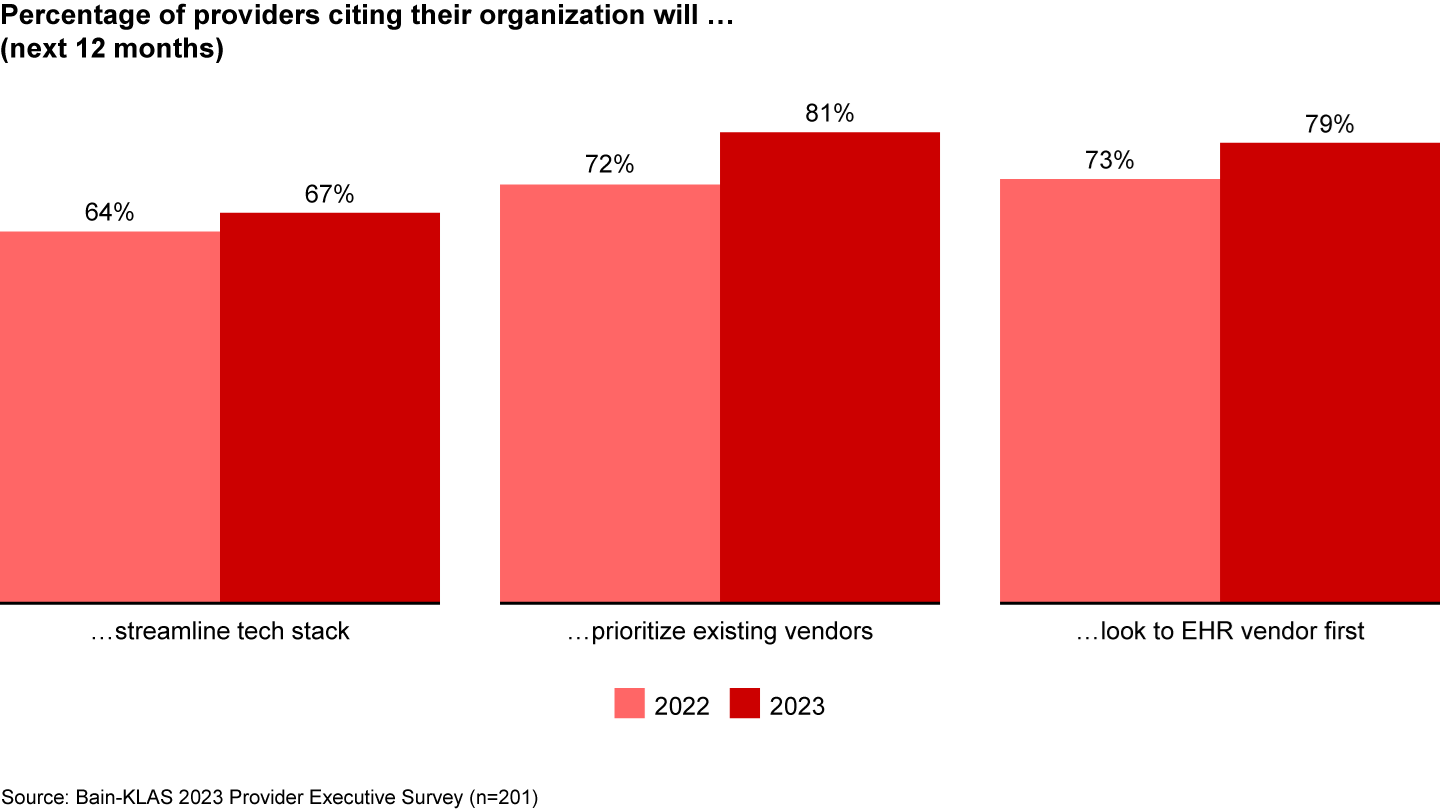
The competitive landscape for PE firms
Healthcare PE investors face increased competition from specialized, tech-focused PE firms such as Vista Equity Partners, Francisco Partners, and Thoma Bravo that are aggressively pursuing healthcare with their software expertise, as well as increasing interest from strategics such as Thermo Fisher. On the other hand, this increased competition also creates attractive exit pathways for PE investors. Questions remain around which segments of the market may be played out, what the next tech trend is, and how to manage risk: Is specialty HCIT insulated from Epic? What value-based care technologies are scalable? What pharma IT solutions can become platforms?
Given the speed at which HCIT is evolving, and the presence of new competitors, the importance of a clear fund strategy, integrated diligence, and ability to underwrite post-acquisition value creation levers will be ever more important in the near future.